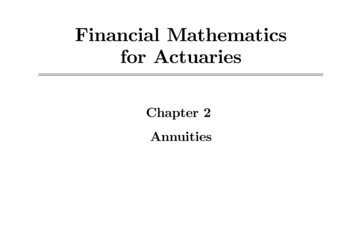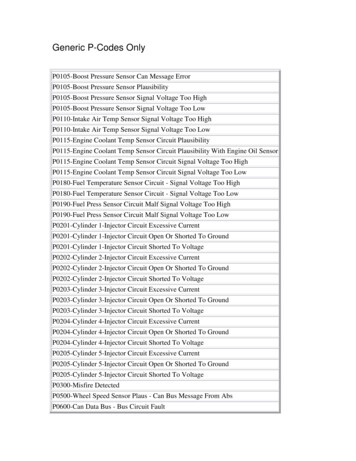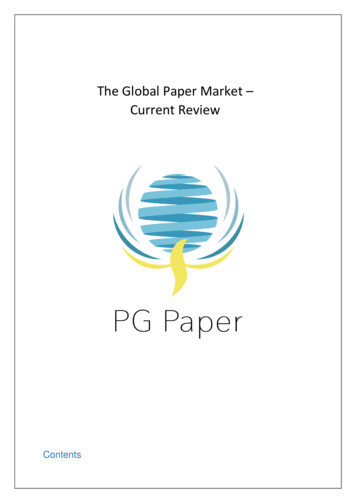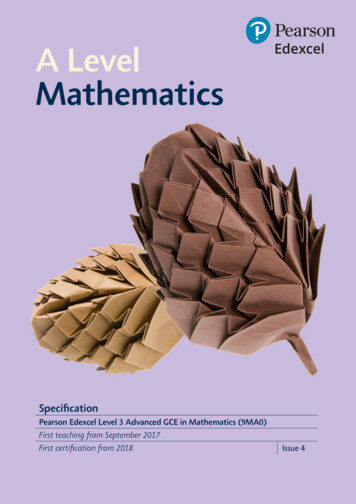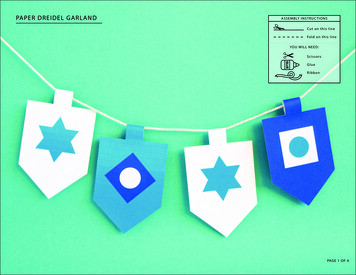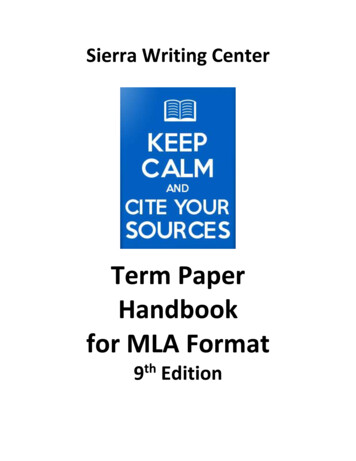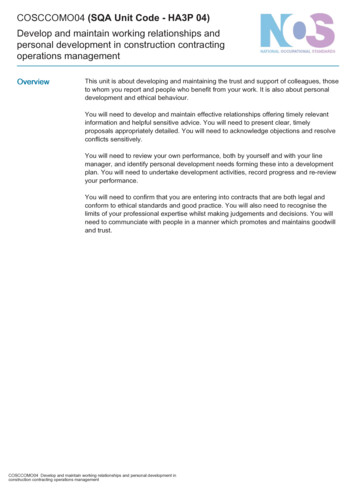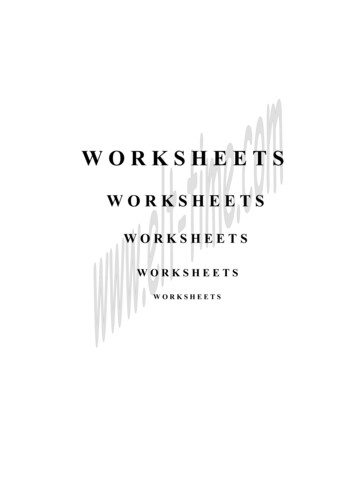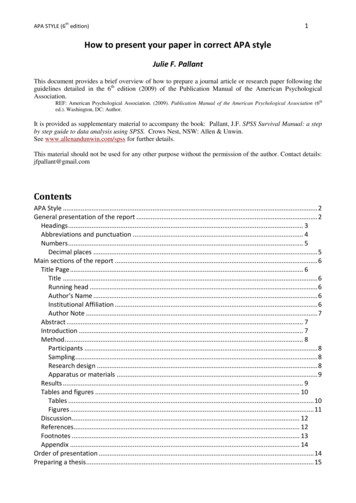
Transcription
th1APA STYLE (6 edition)How to present your paper in correct APA styleJulie F. PallantThis document provides a brief overview of how to prepare a journal article or research paper following theguidelines detailed in the 6th edition (2009) of the Publication Manual of the American PsychologicalAssociation.REF: American Psychological Association. (2009). Publication Manual of the American Psychological Association (6thed.). Washington, DC: Author.It is provided as supplementary material to accompany the book: Pallant, J.F. SPSS Survival Manual: a stepby step guide to data analysis using SPSS. Crows Nest, NSW: Allen & Unwin.See www.allenandunwin.com/spss for further details.This material should not be used for any other purpose without the permission of the author. Contact details:jfpallant@gmail.comContentsAPA Style . 2General presentation of the report . 2Headings . 3Abbreviations and punctuation . 4Numbers . 5Decimal places . 5Main sections of the report . 6Title Page . 6Title . 6Running head . 6Author’s Name . 6Institutional Affiliation . 6Author Note . 7Abstract . 7Introduction . 7Method. 8Participants . 8Sampling . 8Research design . 8Apparatus or materials . 9Results . 9Tables and figures . 10Tables . 10Figures . 11Discussion . 12References. 12Footnotes . 13Appendix . 14Order of presentation . 14Preparing a thesis . 15
thAPA STYLE (6 edition)2APA StyleThese guidelines for presenting a report in APA style are adapted from the 6th edition of thePublication Manual of the American Psychological Association published in 2009.American Psychological Association (2009). Publication manual of the American PsychologicalAssociation (6th ed.). Washington, DC: Author.I refer to this throughout the rest of this document as the Publication Manual.The Publication Manual is updated periodically, so check that you have the latest edition. Pleasenote that there have been a number of substantial changes to APA style in this latest 6th edition. Thismeans that earlier editions that may be still available in university libraries are now out of date. Youcan also check the website for the APA Publication Manual at www.apastyle.org to make sure thatyou keep up to date.If you are studying psychology this is the set of conventions that you must follow. Many otherdisciplines have also adopted this style. The Publication Manual sets out the way in which yourreport should be structured, the headings, format, abbreviations, punctuation, references, table andfigure formats and so on. Although many of these conventions may seem 'picky', it is important thatyou adhere to them exactly if you have been asked to comply with APA style for your report. Youmay be penalised if you don't.The Publication Manual details the exact presentation required if you intend to submit your work toa psychology journal for publication. This is formatted in a way that makes it easier for thepublisher to typeset the material for publication. Some universities require you to submit all work inthis format (check with your instructor or supervisor).There are situations, however, where you are not submitting the material for publication; insteadyou are 'publishing' the material in its final form yourself. An example of this is a thesis. Someflexibility in the content and format is allowed in this situation. You should find out therequirements for your particular situation (e.g., assignment, thesis).The Publication Manual is a very detailed book which many undergraduate students find a bitconfusing and intimidating to use. To help with this I have summarized some of the basic points inthe sections to follow. It is still important however that you are familiar with the Manual itself andare able to consult it when necessary.Note. Throughout the following sections I have presented the instructions for APA style in TimesRoman font while the examples are presented in Arial font.General presentation of the reportThe Publication Manual recommends that the report be double spaced throughout, with margins of2.54 cm (1 inch) all around. Use good quality paper, and only print on one side of the paper.Do not 'right justify or fully justify' your report (that is, don't use a uniform right margin, as you seein published books). Set your word processor to ‘left justify’.Normally the font used is Times New Roman, set in 12 points.
th3APA STYLE (6 edition)The start of each paragraph is indented 5-7 spaces (use the tab button), except for the abstract.Each page must be numbered at the top right-hand side of the page in the header section.HeadingsThe Publication Manual gives clear guidelines concerning the format to be used for the differentlevels of headings. These are illustrated below:HeadingnumberExample12Centered, Bold, Uppercase and Lowercase HeadingFlush Left, Bold, Uppercase and Lowercase Heading3Indented, bold, lowercase paragraph heading ending in a period.4Indented, bold, italics, lowercase paragraph heading ending with a period.5Indented, italics, lowercase paragraph ending with a period.For many research reports only three levels of headings are required. In this case, the PublicationManual (2007, p. 62) suggests using heading level 1, 2 and 3, as illustrated below.Method {heading 1}Participants {heading 2}Materials {heading 2}Measures of control. {heading 3}Measures of personality. {heading 3}Procedure {heading 2}Results {heading 1}Discussion {heading 1}References {heading 1}
th4APA STYLE (6 edition)The other levels of headings will need to be used if additional headings are used throughout theintroduction or if you need to divide your results or discussion sections into subsections.Abbreviations and punctuationThe Publication Manual provides very clear guidelines concerning the abbreviations andpunctuation to be used throughout your report. You should check these carefully.Examples of commonly used abbreviations:e.g.,etc.i.e.,vs.et al.,minhrkgfor exampleand so forththat isversusused when you have multiple authors and you have already provided the full citationminutehourkilogramDo not abbreviate the words: day, week, month, year.Do not add an ‘s’ to make abbreviations of units of measurement (e.g., 12 cm not 12 cms).Examples of statistical abbreviations:NnMSDnspdfMdnfrtESEFACIANOVAnumber of subjects in the total samplenumber of subjects in each group or subset of the samplemeanstandard deviationnot significantprobabilitydegrees of freedommedianfrequencyPearson product-moment correlation coefficientvalue of the t-test statisticeffect sizeExploratory factor analysisConfidence intervalAnalysis of varianceNote that some of these abbreviations need to be presented in italics (as displayed above).See page 116-123 in the Publication Manual for other abbreviations to be used for statistical terms.
th5APA STYLE (6 edition)NumbersNumbers below 10 should be presented as words:The sample contained five students .Numbers 10 and above are presented as numerals:The sample consisted of 25 students .You must however present any number that begins a sentence in words:Twenty-five percent of the sample .Where numbers represent statistical or mathematical function or percentages they can be presentedas numbers:Approximately 5% of the sample .Common fractions however are presented in words:two thirds of the group agreed with the statement .Numbers are used when referring to time, ages or points on the scale:3-year-oldsa score of 1 on the 5-point scale represents no agreementDecimal placesThe number of decimal places to be used to report the results of statistical analyses depends on theparticular situation. The rule is a few as possible, while still maintaining sufficient information.Most information can be presented effectively with only two decimal places (e.g., correlationcoefficients, proportions, values of t, F and chi square).When presenting p values you should report the exact value that is output from the computerprogram - this will usually be to three decimal places (p .051).The only exception to this rule is when the program indicates p .000. This should always bepresented as p .001.A zero should be used in front of the decimal place for numbers that are less than 1, but the valuecould exceed 1 (e.g., Cohen’s d 0.50).When the value being calculated cannot exceed 1 (e.g, correlations, proportions, probability values)no zero should precede the decimal point (e.g, r(120) .56, p .001).
th6APA STYLE (6 edition)Main sections of the reportThe report is made up of a number of distinct sections including the title page, abstract,introduction, method, results, discussion, references and appendix. The content and format of eachof these sections is covered in the Publication Manual on pp. 21-40.The key points relating to each section of the report are presented below. For an example of each ofthese sections, see the sample report provided on the website www.allenandunwin.com/spss.Title PageTitleThe title of your report should clearly and concisely capture the essence of your study (in no morethan 12 words). This is not easy to do! Drop any words that are not useful (e.g., 'a study of . . .').Don't include any abbreviations in the title.The title is centred and placed in the top half of the page. It should be typed in uppercase andlowercase, with the first letter of the main words capitalised.Example:Perceived Control of Internal States and WellbeingRunning headThe title page also includes a 'running head'. This is an abbreviated title which will appear on eachpage of the report if it is published (see page 229 of the Publication Manual).It should be all capitals and no more than 50 characters (letters, spaces, punctuation) in length. It ispresented flush left on the title page and all subsequent pages.Example:PERCEIVED CONTROL AND WELLBEINGYou don't need to type the running head on every page yourself: use the 'header and footer' functionof your word processor. Page numbers should be shown on the top right hand side of each page aspart of the header. For an example of this see the top of each page in this document.Author’s NameUnderneath the title type your name (usually your first name, initial and then surname). Do notinclude titles (e.g., Dr). Centre your name under the title.Institutional AffiliationBelow your name put the name of your university or organisation.
th7APA STYLE (6 edition)Author NoteThis section is usually only included for actual journal articles. It is not necessary for studentassignments or theses.In this section provide details of any acknowledgements, conflict of interest, and contact details forreaders. For details of the format, layout etc., see p.24 of the 6th edition of the Publication Manual.AbstractThe abstract provides a brief summary of the main elements of your report. It should describe thequestion that was addressed, the sample used, experimental method, an overview of the mainfindings, and the conclusions and implications of the study. To help you get an idea of what isrequired in the abstract have a look through journals published in your topic area. Collect examplesof good concise abstracts to use as role models. See p.27 of the Publication Manual for more details.The abstract is presented on a page of its own (page 2), using the heading 'Abstract', which iscentred. The first line is not indented but starts flush with the left margin.The word limits for an abstract varies across journals (typically 150 to 250 words). Check theguidelines before submitting.IntroductionThe introduction indicates the problem that is to be addressed and reviews the relevant literature inthe topic area (using citations as appropriate). In the closing section of the introduction, the purposeor rationale of the study is presented and the specific hypotheses stated. See p.27-28 of thePublication Manual for more details.The introduction is presented on a new page (page 3). Unlike the other sections of the report, it isnot labelled 'Introduction'. Instead the full title of the report is presented at the top, centred, with allmain words starting with a capital letter.All paragraphs are indented 5-7 spaces (use the tab button).Throughout the introduction, you must acknowledge the sources of all the information that youprovide (references). Depending on the circumstances, there are a number of different ways this canbe done.When you need to quote multiple references they should be listed in alphabetical order, separatedby semi-colons. When two authors are involved in the one reference, their names are separated by'&'.Many studies have explored the role of control perceptions in a variety of physical illness such ascancer, AIDS, cardiac disease and arthritis (Helgeson, Jenkins & Pargament, 1988; Taylor, 1983).When the authors' names are provided in the sentence text (rather than in brackets) the names are separatedby 'and', rather than '&', as in the previous example.Thompson and Spacapan (1991) distinguish three main categories of perceived control.
th8APA STYLE (6 edition)For direct quotes you must provide the page number.According to Taylor (1986) psychological control is 'the sense that one can anticipate or predictthe events that occur in one's environment and that one can influence or modify them' (p. 329).When you have a reference that has three or more authors and you have already referred to thisreference, you may condense the reference using et al. for all subsequent uses of this reference. Thefull reference, giving all authors' names, must be provided in the reference section at the end of thereport. in the series of studies conducted by Chapman, Skinner and Baltes (1990). Research by Chapmanet al., suggests that competence beliefs are more strongly related to cognitive performance.MethodThe method section is not presented on a new page, but flows on from the end of the introduction.The format and position of the heading will depend on which levels of headings you have chosen touse in your paper.The method describes exactly how your study was conducted, with sufficient detail that anotherresearcher could repeat the study. The method is divided into a number of subsections (these willvary depending on the type of study that you conducted, and the information needed to describeyour study).ParticipantsThis section contains a brief description of the subjects or respondents included in your study. Forstudies involving humans you should report the major demographic characteristics of the sample(age, sex, race, education level etc.) giving both numbers and percentages of subjects in eachcategory (e.g., males, females), and mean and standard deviations for continuous variables. Give thetotal number of subjects and the number of cases in each experimental condition. Also indicate any'drop-outs' or subjects that did not complete participation in the study.SamplingProvide details of how you selected participants, the type of sampling method used, and whatpercentage of those invited actually agreed to participate.You should mention the intended size of your sample, and whether the actual sample differed fromthis. Provide details of how the intended sample size was determined (e.g., power calculations).Provide details of the settings or locations where the data were collected and any ethics approvalsobtained.Research designProvide details of the research design used in the study. Describe in detail how participants wereassigned to experimental groups (e.g., random assignment). You should provide sufficient detail toallow someone else to replicate your study.
th9APA STYLE (6 edition)Apparatus or materialsIn a study involving a laboratory experiment here you would describe the equipment used under theheading 'Apparatus'. You also describe the tools to measure the dependent variable.If a survey or questionnaire design was used, you will need to describe the scales or questionnairesused under the heading 'Materials'. Details of the reliability and validity of the scales would bereported, along with the Cronbach alpha values obtained in the current study.For full details of the requirements of Method section see p.29 of the Publication Manual.ResultsIn the results section you would describe your data, the statistics used and the results of thedescriptive and inferential techniques used. This section should be brief and to the point, butprovide sufficient detail that the reader can understand what was done. It needs to be wellstructured, perhaps following the order of the hypotheses that were specified in the introduction.Remind the reader of each hypothesis, describe the statistical analysis used and report the results.Don't attempt to explain the results (except where it is necessary to perform an additional analysisto explore the outcome further). The interpretation of results should be saved for the discussionsection.When reporting the results of statistical analyses you need to include the name of the test (e.g.,independent samples t-test), the value obtained, the degrees of freedom, the probability level, theeffect size and the direction of the effect (e.g., were males higher or lower than females). Whereappropriate, you may also need to report the mean, standard deviation and number of subjects foreach group.Statistical abbreviations (e.g., r, t, M, SD) should be presented in italics as shown in the examplesbelow:Example of correlation results:The strongest Pearson product-moment correlation coefficient for the PCOISS was with thePerceived Stress scale: r(425) –.58, p .001.Example of ANOVA results:Analysis of variance showed a statistically significant difference at the p .05 level in LOTscores for the three age groups: F (2, 432) 4.6, p .01. Post-hoc comparisons using the TukeyHSD test indicated that the mean score for Group 1 (M 21.36, SD 4.55) was significantlydifferent from Group 3 (M 22.96, SD 4.49).Example of t-test results:A paired samples t-test showed a statistically significant decrease in FOST scores from Time 1 (M 40.17, SD 5.16) to Time 2 (M 37.5, SD 5.15), t(29) 5.39, p . 001 (two-tailed). The meandecrease in FOST scores was 2.27 with a 95% confidence interval ranging from 1.66 to 3.68. The etasquared statistic (.50) indicated a large effect size.
th10APA STYLE (6 edition)Sometimes the results of analyses can be presented more clearly in table or graph format, ratherthan described in a paragraph. Don't go overboard with graphs though, save these for dramaticeffect (e.g., when presenting significant ANOVA interactions).All tables and figures must be referred to in the text and sufficient explanations provided to ensurethat the reader can understand what is presented.There are some quite strict guidelines for the formatting of tables and figures. The basics arecovered in the next section, however I recommend that you consult the Publication Manual (see pp.125-161).When submitting an article manuscript for publication the tables and figures are presented at theend of the manuscript following the references.For a thesis, however, the tables are incorporated in the main body of the report. You should checkwith your lecturer or supervisor concerning the specific requirements for your report.Tables and figuresFor more information on APA requirements for tables and figures see the Publication Manual (seepp. 125-161).TablesWhen using tables you do not use vertical lines in the table, each table must be numberedconsecutively, and a clear concise title provided.The main words in the title are capitalised.The table title always appears above the table that it refers to. The actual title is italicized andpresented on a different line to the table number.Both the table number and title start on the left margin.Where necessary provide a note at the bottom of the table to explain material in the table (e.g.,abbreviations used).General notes are provided first following the word Note. in italics, and then specific notes can beadded using the superscripts a b c and so on.Probability values are presented below the notes starting with an asterisk (e.g., * p .01.)
th11APA STYLE (6 edition)For example:Table 1Pearson Product-Moment Correlations of the PCOISS and Mastery Scale with Measures of WellbeingPCOISS aMastery scale bSatisfaction with Life scale.37 **.44 ***Positive Affect scale.55 ***.43 ***Negative Affect scale-.57 ***-.46 ***Perceived Stress scale-.58 ***-.61 ***ScaleNote. PCOISS Perceived Control of Internal States Scale.an 425. b n 410.** p .01. *** p .001.FiguresFigures are numbered consecutively (Figure 1, Figure 2) but separately from tables. The figurecaption is presented below the figure that it refers to.In the figure caption, the world 'Figure' and the number of the figure is italicized, however the titleis not (see example below).Unlike tables, the main words in the caption are not capitalised (only the first word). The figurecaption finishes with a full stop. Full instructions for the display of figures are available in thePublication Manual (p.150-161).For example:Figure 1. Comparison of PCOISS scores for males and females across five age groups.
th12APA STYLE (6 edition)DiscussionIn the discussion section you should attempt to integrate or pull together all the various sections ofyour report. This involves a summary of the main findings of the study, followed by yourinterpretation of these results in light of your literature review presented in the introduction.According to the Publication Manual (2009), in this section you ‘examine, interpret, and qualify theresults, and draw inferences and conclusions from them' (p. 35).At the start of the Discussion section indicate whether your original hypotheses were supported ornot.You should compare your results with previous research and suggest reasons for any differencesfound. Highlight any sources of potential bias or confounding variables, any issues relating to themeasurement of your variables, or the effectiveness of any experimental manipulation.Limitations or weaknesses of your study should be identified and discussed. In particular youshould consider the generalisability of your findings to other groups and contexts and any factorsrelating to your sample or study design that may impact on this.You should consider the broader implications (theoretical, clinical and practical) of your findingsand make suggestions for future research.ReferencesThe references section starts on a new page and provides details of the literature that was referred toin your report. Do not include other background material that you may have read but did not refer tospecifically in your literature review.The references are presented in alphabetical order by author. Multiple entries by the same authorare ordered according to the year of publication, with the earliest listed first. References that havethe same first author but different second authors are presented alphabetically by the surname of thesecond author. For more details on these conventions, see the Publication Manual, p. 181.Each reference is presented on a new line, using a ‘hanging indent’ (as shown in the examplespresented below). A quick way to get a hanging indent: in Microsoft Word highlight the referenceor place your cursor at the start, hold the Ctrl key down and press the T key on the keyboard. Toundo a hanging indent hold both the Ctrl key and the Shift key down and press the T key until thetext returns to the left margin.The very strict guidelines for the format used to present the different types of material (journalarticles, books, chapters) are detailed in the Publication Manual on pp. 169-224. I have providedexamples of some of the more commonly used reference types below.Note. One of the main changes in the 6th edition involves the inclusion of DOI numbers for journalarticles. These are ‘digital object identifiers’ that are assigned to journal articles and other onlinematerial to uniquely identify each publication. This information is provided on the first page ofmost journal articles.If this information is available (some journal articles, particularly older ones don’t have one) youneed to include this information in your reference list as shown in the example provided below.
th13APA STYLE (6 edition)Examples of different types of references:Journal article one author more thanone authorLee, S.A. (2009). Measuring Individual Differences in Trait Sympathy:Instrument Construction and Validation. Journal of PersonalityAssessment, 91, 568-583. doi:10.1080/00223890903228620Watson, D., Clark, L., & Tellegen, A. (1988). Development and validation of briefmeasures of positive and negative affect: The PANAS scales. Journal ofPersonality and Social Psychology, 54, 1063–1070. doi:10.1037/00223514.54.6.1063Book one authorSmithson, M. (2000). Statistics with confidence. London: Sage. more thanone authorThoresen, C. E., & Mahoney, M. J. (1974). Behavioral self-control. New York:Holt, Rinehart & Winston. latereditionsGoodwin, C. J. (1998). Research in psychology: Methods and design (2nd ed.).New York: John Wiley. edited bookRobinson, J. P., Shaver, P. R., & Wrightsman, L. S. (Eds.). (1991). Measures ofpersonality and social psychological attitudes. Hillsdale, NJ: AcademicPress. chapter inan editedbookThompson, S. C., Cheek, P. R., & Graham, M. A. (1988). The other side ofperceived control: Disadvantages and negative effects. In S. Spacapan &S. Oskamp (Eds.), The social psychology of health (pp. 69–93). NewburyPark, CA: Sage.FootnotesFootnotes are only used if you need to add extra information concerning a particular point you havemade in the main body of the article.These should be numbered and presented in the order they appear in the manuscript using asuperscript number 1The list of the footnotes can be presented on a separate page at the end of the paper after thereferences.1. The PCOISS was developed as part of a multidimensional, multidomain inventory.Copies of this inventory can be obtained from the author.
th14APA STYLE (6 edition)AppendixIf you have additional material that the reader might like to refer to, but is not central to your report,this can be provided in the appendix. This could include the items of a scale used in thequestionnaire, the results of additional analyses conducted, or an example of res
It is provided as supplementary material to accompany the book: Pallant, J.F. SPSS Survival Manual: a step by step guide to data analysis using
